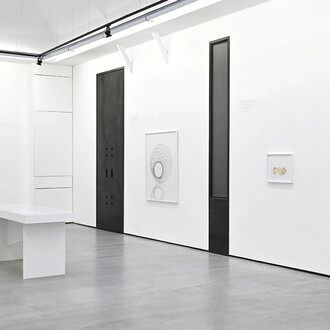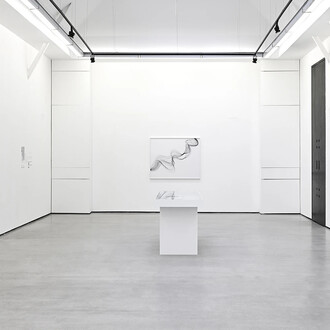Pierre Yves Bohm creates a dialectical dialogue between shape and shapelessness. He juggles violent electric shock and slow, reflective labour. He « spits paint » and « squeezes the image like a lemon » in a burst revealing a vital tension just as much as an unremitting quest. Though not identifying himself with this abstract and instinctive approach, he nevertheless doesn’t hesitate to spit paint on our faces, to deliver the matter with rage. The title of his show refers to one of his heads modeled on a simple metal rod, paint spurting from the mouth. A self-portrait ?
By puncturing the canvas, spreading the paint from the front and back, leaching out the work with turpentine, multiplying layers and colored constellations, he applies himself to a meticulous distorsion, and covering of the pattern. Following a proven system, the artist invests his canvases with a vibratory force and injects an active, almost magical charge to the matter. Could it be a way to claim pure visual expression as the sole subject of his paintings ? Like a palimpsest, Peinture Kacht is the perfect example of an initial subject — a character with animals — which « got complicated from the inside », like a reality in metamorphosis.
At the heart of his artistic process is the willingness to dominate, cover up or abstract the design in order to only keep the visuel density. It is about keeping away, pushing back every possible literal explanation, escape any historical or societal truth in order to universalize it. It is about displaying an enigma in order to foil an evidence that would be too engaging, too fast or too simple.
Indeed, the subject only seems to be a pretext, a lure fed with references suggesting man’s atrocities or those of a mysterious and unknown world. Filled with humanist preoccupations, Pierre Yves Bohm’s paintings explore recurring themes such as suffering or death (Untitled, 2013). The drawings in Gardien de camp : Tatouages et dessins du goulag by Dantsig Baldaev build a lexicon of recurring shapes. The same design sometimes used for different works is distorted in completely different ways like the ghostly faces in Chero lirhta, Chero mit Grala or the great figure in Untitled, 2013.
The titles refer to a gypsy dialect, coming from Bohemia (the land of the Bohm’s ?) : Grabo oun frioro thus means « Spring mass grave ». These references popularize the access to visual expression and question the abstract motif without complexifying it. The eye must therefore lose itself in this maze of meaning in order to create a space of its own defying the depth created between planes (Hommage à Hokusaï or Tat mulo), of a bi or three-dimensional representation. One only has to compare the painting entitled Les cauchemars de Dantzig Baldaev or the sculpture Peinture objet from the early years. Isn’t it about going beyond what is visible in order to open up the mind’s widest regions, to free paintings from the limits of representation in order to probe the human thoughts and depths with the shapeless ?
Mélanie Lerat, curator at the Musée des Beaux-Arts in Arras (2016).



















